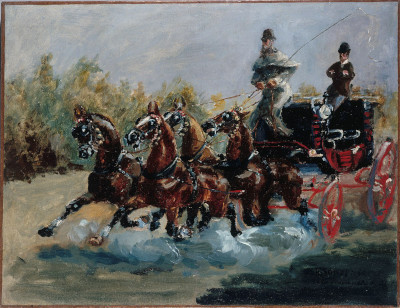Head to the Petit Palais in Paris to see Alphonse de Toulouse-Lautrec Driving his Mail-Coach from 1881. It was painted by his son, Henri, when just seventeen years of age and still very much developing as an artist.
The artist's father loved hunting, more than perhaps anything else, and was particularly unhappy when he realised that his son would never become involved in such a pastime. The closest that Henri could get would be to produce paintings such as this, due to his physical deficiencies. At this time in his career he was still growing as a man and an artist, and it would several years before his cabaret artworks would start to appear. At seventeen, he focused on scenes around his parent's property, with animals being commonly featured. White Horse Gazelle would be one example of that. The alternative piece in front of us here is, of course, much more complex and also gives us further information about Henri's relationship with his father. He is complementary to Alphonse in this depiction, and perhaps hoped to strengthen their bond by producing this piece.s
The brushwork is loose and expressive within Alphonse de Toulouse-Lautrec Driving his Mail-Coach. We find the rider with companion stood up as the horses hurtle forwards at great speed. The style of the painting helps to create this feeling of speed and momentum as they head past the artist. Four horses carry the carriage ever onwards, with trees gathered in the background, with a flat blue sky behind. Detail is kept to a minimum, akin to a study piece, where forms are shown, but without too much development and blending of tones. See the undercarriage of the vehicle, for example, which is left as simple red lines and the odd touch of white paint. It may have been intended as a preparatory piece in which the composition is laid out, before a later version would produce a smoother blend of oils and more precise detail.
This painting can today be found at the Musée du Petit Palais, Paris. It is around half a metre in width, and is dated at 1880. It is not typical of how most people remember this artist, but actually is in line with his early work, in which horses appeared fairly regularly. It is certainly not unusual for any artist to go through a period of development at this stage, particularly when they avoid the normal routes of artistic teaching. We do know that the artist's father was a difficult individual who struggled in his relationship with his son. It is not known if this artwork helped to bring them closer together, but Henri surely hoped that would be the case.




